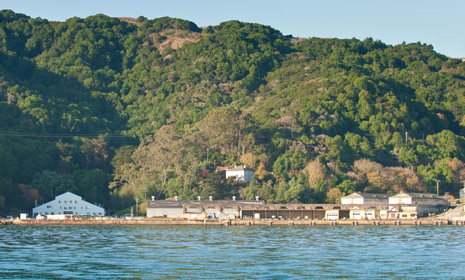Before becoming a hub of innovative scientific research, the Romberg Tiburon Center site—a complex of industrial buildings and structures nestled among the homes on the Tiburon Peninsula—had a rich history.

The waterfront property that is now home to the Romberg Tiburon Center has a rich and varied historical past.
By Dr. Toby Garfield and Erin Blackwood
Published: April 1, 2011
At the beginning of the twentieth century, the Navy purchased the site for use as a ship coaling station. The long cement railcar trestle, offshore pilings, water tower on the hill, and commander’s quarters (now a guest house for visiting scientists) on the hill above the trestle are among the remnants of this period. Ships from the Mare Island Navy Yard bunkered at Tiburon on their way to sea. In 1908, President Theodore Roosevelt’s Great White Fleet bunkered at Tiburon during its legendary cruise around the world. From 1931 to 1940, the Navy loaned the base to the State of California, which established its first nautical training school there. With the outbreak of World War II, the Navy took the site back, and the Maritime Academy relocated to its present site near Vallejo.
Around this same time, at the north end of the property, Roebling and Sons was weaving the steel hanger cables that connect the highway deck to the two main suspension cables of the Golden Gate Bridge. The two bulkheads at the property’s north end are all that remain of this operation. SF State’s Ceramics Department now uses this area for pit firing.
In 1939, the Navy added the Roebling and Sons property to its holdings in order to establish the Naval Net Depot, a construction facility for anti-submarine and anti-torpedo nets, including a net seven miles long and 7,000 tons in weight that was strung across the entrance to San Francisco Bay. Other nets were shipped to Navy bases along the West Coast and across the Pacific.
Most of the current buildings on the site are from the Net Depot days. They include the large concrete construction warehouse at the property’s south end (now the main laboratory, offices and classrooms), the enlisted men’s barracks behind the trestle (now RTC’s facilities shop, laboratory space, and studios for SF State’s Art students) and mess hall, the auditorium (more laboratories), the command post, and at the top of the hill, the officer’s housing and club (now the Bay Conference Center) next to the water tower.
The Navy Net Depot was active through the Korean War. In 1958, operations ceased and the Navy transferred the property to the Department of Commerce. In the 1960s, the property became the National Marine Fisheries Service’s Southwest Fisheries Center (NMFS), and in 1973, NMFS consolidated its operations to 10 acres of the 37-acre site.
In 1977, SF State, led by then-President Paul Romberg, submitted a proposal to develop a field station and marine laboratory dedicated to the study of San Francisco Bay, and the Romberg Tiburon Center was born on the remainder of the site the following year. Since then, in addition to several building renovations, SF State has constructed a greenhouse, bay water intake system including several small habitat tanks that were built near the boat ramp, and a small research pier.
With over 100 people on-site daily, research at RTC now covers most of the sensitive issues in the Bay, including the impact of freshwater diversion, human additions of nutrients and chemicals, invasive species, wetlands restoration, climate change, alternative biofuels, and current circulation patterns. Along with RTC, the San Francisco Bay Estuarine Research Reserve is headquartered on the property, and there are additional collaborating tenants, including the Smithsonian Institute’s Invasions Lab and Taxon Biosciences. The Tyee Club and Tiburon Salmon Institute raise salmon during the summer in waterfront pens.
In addition to its rich history, the site is special because it is one of the few places in the Bay where the water is deep enough to allow oceangoing ships to come right up to the shore. In most regions of the Bay, piers must extend far out from the shore to reach deep water or dredging operations have to create artificially deep channels. RTC plans to take advantage of this feature by rebuilding the old coaling station wharf to accommodate larger research vessels and provide a staging area for future natural disaster or other emergency responses.
Each year in October, the Center hosts Discovery Day, when the public is invited to tour parts of the laboratory and learn about the research from the scientists themselves. RTC’s weekly seminar series is open to the public and posted on their website. To learn more about RTC and the research being conducted on San Francisco Bay, visit rtc.sfsu.edu.

